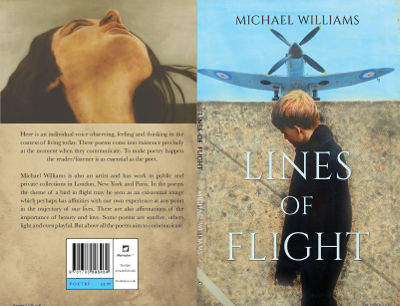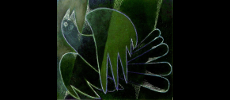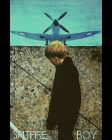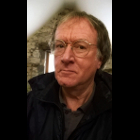Biographie  Fr
Fr
 Eng
Eng
Michael Williams a gagné ses diplômes à L’École des Beaux-Arts de Saint-Martin Londres et l’Université de Londres. Les années suivantes il a eu plusiers expos à Londres. Mais, malgré leur succès, il était décu par la tendance aux valeurs marketing de l'art contemporain. Il fait les études plus à l’Université de Manchester et à Edimbourg, puis il a travaillé dans le domaine socio-éducatif en Ecosse.
Là, il a créé un réseau de soutien pour l’intégration socio-éducatif des enfants en difficultés et leurs familles. Devenu une référence, ce modèle était étendu dans le système éducatif par le gouvernement écossais.
Finalement, il démissionnera pour encore se consacrer à temps complet à son art. Tout au long de cette période Michael a continué à exposer ses œuvres d'art et à écrire ses poèmes et ses histoires pour les enfants.
Ainsi, après que leurs enfants avaient volé de leur nid avec succès, Michael et sa femme ont quitté l’Écosse pour vivre définitivement en France. Aujourd’hui, il a travaillé là depuis plus de vingt ans en tant qu'artiste et écrivain.
L’artiste a d’abord été reconnu pour ses sculptures, puis aujourd'hui pour ses peintures - toujours avec leur profondeur de couleurs.
Michael Williams est présent dans des collections publiques et privées, par exemple, en Angleterre, Écosse, Etats-Unis, Allemagne, Pays-Bas et bien sûr en France ! Les expositions en France se trouvent en Dordogne, Corrèze, Lot, Cantal et Paris (Montparnasse).
Comme écrivain, il a donné des lectures de poésie à Londres, Manchester, Edimbourg et Paris. La publication la plus récente (mars 2017) titré « Lines of Flight » Poetry (in English) est disponible ici :
Biography 

Before moving to France, nearly twenty-five years ago, Michael Williams had lived mostly in Scotland, but also in the north of England and in Ireland. Having graduated from St. Martin’s Art School London and London University he had successful exhibitions in London, Manchester and Scotland. Despite this his personal convictions were against the marketing trends in the art world. He left London to work in Scotland with children in difficulties and their families.
After further studies at Manchester University and Edinburgh he pioneered a network support aimed at integrating all children into the mainstream Scottish educational system.
This network model was assimilated into the Scottish educational system and culminated in a consultancy position with the Scottish government in Edinburgh. Throughout this period he continued to exhibit his art work and to write poetry and stories for children.
Michael and his wife now live in France where he has worked full-time for over twenty years as artist and writer.
The work of Michaël Williams is in public and private collections in several countries: Canada, United States, Netherlands, Germany, Scotland, England etc. and of course in France.
Exhibitions in France include the regions of Correze, Lot, Cantal, Dordogne and Paris (Montparnasse). Latest published work : “Lines of Flight” (Poems), Troubador available from bookshops (e.g. Waterstones) :
Discours 

"Discours :Expo La Chapelle des Capuçins 2019 " :
Bonjour et bienvenue à tous. Merci de votre présence ce soir. C’est impressionnant et touchant à vous voir si nombreux.
Il y a deux ans depuis ma dernière expo ici dans cette magnifique chapelle. Vous vous souviendrez, peut-être, à cette dernière expo ici, j’avais mentionné ces murs et ces pierres qui écoutent nos histoires alors que nous passons. Après ces deux ans, ces mêmes pierres sont encore là, à côté de nous. Même si, tristement, nous avons quelques amis et voisins qui ne sont pas plus avec nous. Mais ces pierres, ils sont ici pour tout le monde qui passe depuis quatre cents ans. On peut imaginer les maçons sur un échafaudage simple, à la construction, pierre sur pierre, tout à la main. Et, petit et petit, pendant tous les matins jusqu’aux soirs, tous les jours de travailler, ils ont dépensé leur histoire personnelle, et au même moment, ils ont créé la vraie histoire des siècles dans cette configuration de ces pierres.
Aujourd’hui, je pense, nous vivons plus en plus dans une réalité virtuelle où les mots et les images sont toujours manipulés. Nos informations sensorielles de l'œil, la main, l’oreille, presque toutes les vérifications de notre réalité humaine, sont fragmentées et recomposées ou supprimées.
Depuis ma jeunesse j’ai beaucoup admiré quelques artistes français qui ont travaillé avant et après la deuxième guerre mondiale. Pour eux, pendant les années de leurs jeunesses suivant cette guerre, les valeurs des artistes français, on était écrasé par une culture émergente des valeurs plus populaire et commercialisé. Pour la brévité, je vous donne un seul exemple des artistes français, j’admire de cette période - c’est Roger Bissière. Pendant sa jeunesse, malgré le tumulte et son service dans la guerre mondiale, il a cherché son héritage esthétique et les valeurs sensorielles et spirituelles. Bissière a vécu une partie importante de sa vie pas loin d’ici, vers Cahors.
Je ne suis pas le seul qui croit Bissière était un des grands-maîtres du vingtième siècle. Mais, aujourd’hui, il n’est pas très bien connu parce que son œuvre a été ignoré, même effacé, par l’influence dominant des États-Unis. Alors, pendant le vingtième siècle, les valeurs de la culture européenne ont renommé « vieil européen » en poursuite de la dominance des valeurs populiste : c'est-à-dire dirigé par les intérêts plus en plus des méthodes du marketing. En effet, c’est une culture de masse dirigée pour augmenter la richesse de très peu des gens.
Vers la fin de la vie de Bissière, il y a un événement quand cette domination des épinions culturel était clairement indiqué. C’était par l'un des plus importants concours de l’art à l’échelle mondiale : la Biennale de Venise. En mille neuf cent soixante-quatre le jury de la Biennale de Venise décerne « après des débats ample et approfondis » une mention d’honneur à Bissière « en reconnaissance de l’importance historique et artistique de son œuvre ». Mais, à noter bien, malgré son importance c’était seulement « une mention » pour Bissière. Actuellement, le premier prix, le plus prestigieux de cette biennale des artistes du monde, le Grand Prix de peinture, était accordé à Robert Rauschenberg, nouveau artiste américaine, décrit comme « pop artiste » dans la presse contemporaine. Suivant ce moment-là, on peut marquer l’éclipse des valeurs artistique de l’Europe et Paris et la prédominance de l’influence de New York.
Alors pour tout le vingtième siècle, ces valeurs européennes ont été vues comme second classe jusqu’à aujourd’hui quand le monde de l’art a été transformé en une sorte de bourse. Par exemple, il y a seulement quelques semaines depuis le plasticien américain Jeff Koons était dans les journaux à cause de la vente d’un œuvre s’appelle, « Lapin ».
Koons est très célébré. C’est un artiste « kitsch néo pop » selon les experts.
Koons a vendu son Lapin en acier. C'était un mètre de haut, ses oreilles de fer compris. Bien sûr, c’est un objet vous jugeriez totalement nul.
Mais non. Attendre. C’était vendu pour quatre-vingt-onze millions de dollars.
Oui, c’est plus qu’absurde. Personnellement, je trouve, c’est obscène dans un monde déshabillé par les flux d’images de détresses et de grandes misères.
Moi, je pense l’art n’est pas un marché ni une sorte de distraction. Je crois, c’est une forme de communication essentielle pour nous et notre équilibré. C’est au cœur de notre culture. Donc on peut dire l’art, c’est une forme de communication sacré. C’est une communication faite également par les sens et le cerveau qui devient, au moment de compréhension, une charge émotionnelle et peut-être d’une reconnaissance pour nous-mêmes. Je pense l’art doit être le moment de l’engagement entre l’œuvre et la personne qui le regarde. Parce que je crois l’art n’est pas comment l’œuvre se reporte, mais comment on la ressent.
Encore positif, je crois on peut voir aujourd’hui les débuts d’une réformation. Nous avons déjà commencé une autre époque et nous pouvons voir un changement dans notre culture. Apparemment, c’est plus en plus populiste et négatif. Mais ça, c’est encore le vingtième siècle en train de mourir. Sois patient. C’est toujours dans les arts que l’on peut voir les premiers signes d’une nouvelle vision. Dans le monde de l’art rien n’a disparu définitivement. Parce que l’art n’est pas simplement quelques choses à la mode. Par exemple, les œuvres dans les caves à Lascaux sont toujours là. Ils parlent dans une langue de l'œil et la main, toujours humaine. C'est une communication qui peut encore nous toucher aujourd’hui. De la même façon, il n’y a pas, jamais, une « vielle Europe » qui est devenu vieux-façonné et passé. Actuellement, c’est notre culture européenne qui a les valeurs et les moyens d’une communication plus humaine, plus profonde et plus durable. Sois patient et positif.
Encore ces pierres nous entendent. Et nous ? Peut-être nous sommes un peu comme les maçons : d’entre nous, chacun fait sa propre histoire dans la vie. Aujourd’hui l’avenir et ses valeurs : c’est à nous de construire.
Merci de m'avoir écouté si attentivement.
Michael Williams Turenne 2019
Discourse 

"Speech: Expo Capuçins Chapel 2019" :
Hello and welcome to all.
Thank you for being here tonight. It's impressive and touching to see you are so many.
It is two years since my last exhibition here in this magnificent chapel. You will remember, perhaps, at that last expo here, I mentioned these walls and stones listening to our stories as we pass. After these two years the same stones are still here, next to us. Although, sadly, we have a few friends and neighbors who are no longer alongside us. These same stones have been here for all those who have been passing by for four hundred years. One can imagine the masons on a simple scaffolding, building these walls, stone on stone, everything by hand. And, little by little, every morning until the evenings, every day of working, they spent their personal history, and at the same time, they created a lasting history of the centuries in the configuration of these stones.
Today, I think, we live more and more in a virtual reality where words and images are always manipulated. Our sensory information from the eye, the hand, the ear, almost all the verifications of our human reality, are fragmented and recomposed or deleted.
Since my youth I admired many French artists who worked before and after the second world war. For them, during the years of their youth following that war, the values of French artists were crushed by an emerging culture of values more popular and commercialized. For the sake of brevity I will give you only one example of the French artists I admire of this period: it is RogerBissière. During his youth, despite the tumult and his service in the world war, Bissière sought his aesthetic heritage in sensory and spiritual values.
Bissière lived an important part of his life not far from here, towards Cahors. I am not the only one who believes Bissière was one of the great masters of the twentieth century. But today he is not very well known because his work has been ignored, even erased, by the dominant influence of the United States. So, during the twentieth century the values of European culture were renamed "old European" in pursuit of the dominance of populist values: that is to say, directed by the interests more and more of the methods of marketing. Indeed it is a form of mass culture directed to increase the wealth of very few people.
Towards the end of Bissière's life there is an event when this domination of cultural opinions was clearly indicated. It was in one of the most important contemporary art events on a worldwide scale: the Venice Biennale. In nineteen sixty-four the jury of the Venice Biennale awarded "after extensive and thorough debates" an honourable mention to Bissière "in recognition of the historical and artistic importance of his work". But, note well, in spite of its importance it was only "a mention" for Bissière. Actually the first prize, the most prestigious in this biennale of artists of the world, the grand prize of painting, was awarded to Robert Rauschenberg, a new American artist, described as "pop artist" in the contemporary press.
Following this moment we can note the eclipse of the artistic values of Europe and Paris and the predominance of the influence of New York. So for the remaining part of the twentieth century these European values were seen as second class. And this continues until today when the art world has been transformed into a kind of stock market. For example, only a few weeks ago the American artist Jeff Koons was in the newspapers because of the sale of a work called Rabbit.
Koons is very famous. He is a “kitsch neo-pop artist” according to the experts. Koons sold his steel Rabbit which is one metre tall,with its steel ears included. Of course it is an object you would most probably consider totally null. But no. Wait a moment. It was sold for ninety-one million dollars.
Yes, that is more than absurd. Personally, I find it is obscene in a world exposed by the flow of images of distress and great misery.
Personally, I do not think art is a market or a kind of entertainment. I believe it is a form of communication between us essential for our well-being. It's at the heart of our culture. So we can say that art is a form of sacred communication. It is a communication made also by the senses and the brain that becomes, at the moment of understanding, an emotional charge and perhaps a recognition of ourselves. I think art should be the moment of engagement between the work and the person seeing it. Because I believe art is not how the work represents, but how it feels.
Thinking positively, I believe we can see today the beginnings of a reformation. We have already started another era and we can see a change in our culture. Apparently things are more and more populist and negative. But that's still the twentieth century dying. Be patient. It is always in the arts that we can see the first signs of a new vision. In the art world nothing has disappeared definitively. Because art is not just the financial value of things in fashion. For example, the works in the cavess at Lascaux are still there. They speak in a language of the eye and the hand, always human. This is a communication that can still affect us today. In the same way there is not, ever, an "old Europe" that has become old fashioned and irrelevant. Currently it is our European culture that understands the values and means of a more humane, deeper and more sustainable communication. Be patient and positive.
Yet again these stones are listening to us. And, we are a little like the masons: among us, everyone makes his own story in life. Today the future and its values: it's up to us to build.
Thank you for listening to me so carefully.
Michael Williams Turenne 2019






 < >
< > < >
< >
 < >
< > < >
< >

